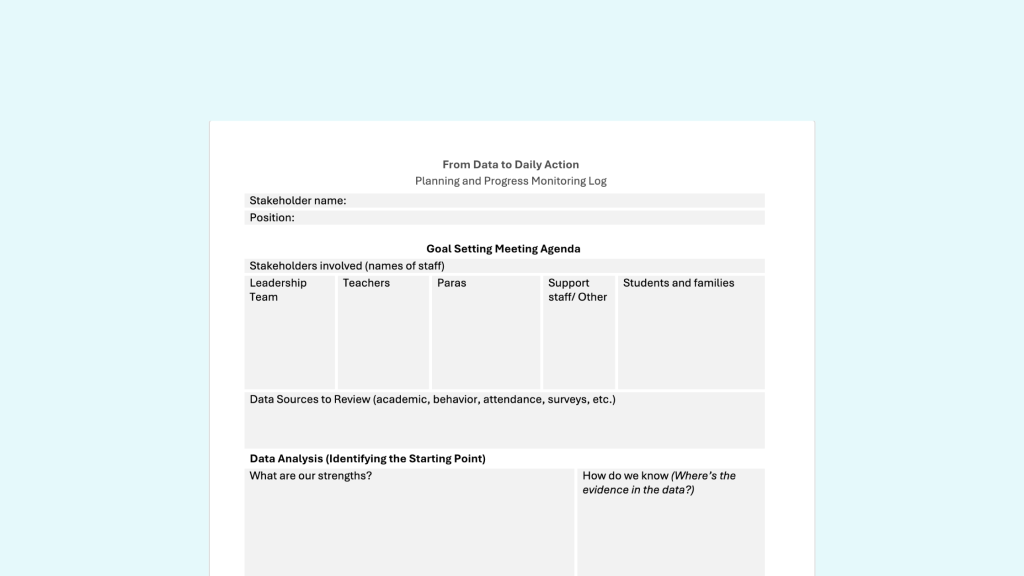Across Texas, school leaders are deep in the work of reviewing STAAR results, reflecting on where their campuses are, and asking, “What do we do next?” This data moment is more than a reflection—it’s the launching point for setting goals and building momentum toward real, sustainable improvement. The process doesn’t have to be complex, but it does need to be thoughtful and action-oriented. Let’s explore how to turn data into daily action.
Five Steps to Move from Data to Action
Here’s a high-level framework you can use to guide your campus or team through the goal-setting process:

1. Gather Stakeholders and Data
Invite varied perspectives and data sources necessary to get a fuller picture of the campus. Consider stakeholders such as classroom teachers, specialists, support staff, and leaders. You want people who can offer different perspectives and share ownership in the work.
Furthermore, intentionally select data sources that will provide a well-rounded view of data trends and additional factors that might impact some of the emerging trends. These might include data on student performance, discipline, MTSS (Multi-Tiered System of Supports) referrals, attendance, and climate surveys.
2. Identify the Starting Point
With this stakeholder team, first, analyze your current data honestly. Then, identify strengths and needs, patterns across student groups, and instructional gaps.
3. Set the Goal
Establish a long-term, measurable goal that clearly defines where you want to go in the next one to three years. This will map out why all the work matters—it’s a goal centered on student success and campus growth. This goal needs to be important and matter to your campus stakeholders.
4. Segment into Smaller Outcomes
Create milestones that mark progress along the way: yearlong or mid-year goals, quarterly targets, and monthly or weekly checkpoints. Then go one step further: shift the focus from outcomes to the daily actions that actually drive progress and improve student outcomes.
5. Review and Accountability
Set dates to review progress toward the segmented outcomes as well as the long-term goal. Identify and include an accountability partner(s) whom you can trust. The ideal accountability partner is someone who will hold you to the high expectations that you set, will ask the honest and hard questions when you need the push, and with whom you can share openly. This is a caring yet firm support to hold you to what you set out to accomplish.

Check out our FREE resource, “From Data to Daily Action Planning and Progress Monitoring Log,” to support you through the Goal Setting Cycle.
Deep Dive into Step 4: Where the Shift Happens
Step 4 is where data review and goal setting become actionable. At this point, leadership teams transition from defining desired outcomes to establishing the daily practices necessary to achieve them.
Why focus on behavior? Outcomes like test scores are lagging indicators. They come at the end of a chain of instructional choices and systems. If we focus our efforts on the leading indicators—the behaviors that staff can control—we build a stronger, more consistent path to the results we want.
Behavior-based goals give your team something to act on every single day. Rather than setting vague aspirations like “Improve math scores,” you’re anchoring your improvement plan in clear, repeatable practices that drive instruction and learning.
Learn more about utilizing data and setting goals with our customizable Principal Support Packages and Assistant Principal Support Packages!
Guiding Questions to Connect Steps 3, 4, and 5
Long-Term Vision- Step 3
- Based on the data, what is the most important goal that will move our campus along? Why does this goal matter?
- When do we want to have this goal accomplished by?
- What would success look like across all student groups?
- What barriers might get in the way, and how can we plan for them?
Milestones and Daily Action- Step 4
- What measurable progress should we see within the next year?
- What data will we use to track quarterly and monthly improvements?
- What consistent adult behaviors will most impact student learning?
- What practices must become part of our campus routine?
Review and Accountability- Step 5
- How will we monitor the implementation of these behaviors?
- What barriers might get in the way, and how can we plan for them?
- When will we meet next to review the campus data? What data will we review, and what will we discuss?
- Who is a good accountability partner for us to bring in that will hold us to our high expectations, and allow for grace and honesty when looking at our data, barriers, and next steps?
Example: Steps 3–5 in Action
Let’s say your campus has identified a significant need in closing foundational literacy gaps and improving reading comprehension.
Long-Term Goal- Step 3:
In two years, 80% of students in grades 3–5 will meet or exceed grade-level expectations in Reading on STAAR.
Milestones and Behavior-Based Actions- Step 4:
- Year 1 Goal: 65% of students will meet or exceed grade-level expectations
- Quarterly Targets:
- Q1: 55% mastery on campus common assessments
- Q2: 60% mastery of mid-year benchmarks
- Q3: 65% on interim assessments
- Monthly Checks: Monitor progress on weekly exit tickets and guided reading data. Review monthly screener data to monitor progress in foundational literacy skills.
Daily and Weekly Actions
- Campus leaders and teachers set T-TESS professional goals to improve the teachers’ instructional practice in reading. Regularly review these goals to keep them front of mind for coaching, PLC, and instructional feedback.
- All classrooms plan and implement Science of Teaching Reading strategies (reading in all content areas and all classrooms)
- All Language Arts classrooms implement targeted reading instruction at least four times per week
- PLCs review reading data every two weeks and adjust targeted reading groups accordingly
- Campus leaders attend PLCs and collaborate with instructional staff to problem-solve and meet students’ needs
- Campus leaders also provide targeted weekly or bi-weekly feedback on instructional strategies supporting reading instruction in all classrooms
Review and Accountability- Step 5
- The campus leadership team meets with the campus principal supervisor or another accountability partner each month to review progress toward benchmarks for success.
- Fall Semester Agenda
- Review milestone/ short-term goal
- Review data- Have we met the criteria?
- September– T-TESS Goals established and reviewed (Data source: BOY Conferences with appraiser and teacher)
- October– Campus leader attendance in PLC and Campus leaders walkthroughs (Data source: Campus leader calendars- planned vs actual, informal observation/ walkthrough data- quantity of walkthroughs and quality of feedback
- November– Targeted reading occurring in classrooms 4 times a week; Q1: 55% mastery on campus common assessments (Data source: walkthrough data, screener data of students in targeted reading groups, and Common Assessment Data for all 3-5 students)
- December– Implementation of STR and teacher growth on reading instruction (Data source: MOY Conference with appraiser and teacher, walkthrough data, teacher survey about STR glow and grow)
- Celebrate successes
- Problem solve for barriers
- Adjust the goal if needed
By focusing on these specific behaviors, your staff will gain a clear path to stronger student outcomes. Also, note that behaviors and goals impact all stakeholders on the campus. To ensure that the campus is moving toward the long-term goal, all stakeholders should have work that supports the overall organizational objectives. (See my previous blog on Cascading Goals for more information on this topic.)
Final Thoughts on Turning Data into Action
As school leaders, we must become comfortable using data not just to reflect on the past, but to illuminate the path forward. The real power lies in how we respond, with goals rooted in the daily behaviors that drive student learning. It is our role as instructional leaders to empower our campus teams to see data as a tool to inform our practices. Finally, when we anchor our goals in what we can control, we shift from reacting to data to leading with purpose. And that’s where real, lasting growth begins.
Natalie is an Educator Evaluation and Leadership Administrative Specialist at ESC Region 13.






Add comment